Speech Three Decades of Real Interest Rates
Today I wish to talk about real interest rates. I do so mainly from an historical perspective, without intending to imply anything specific about the movement of interest rates over the months ahead. Nor am I intending to promote real interest rates as a new yardstick for the conduct of monetary policy; they are much too complex for that purpose.
In fact, the whole topic raises a number of somewhat technical issues which we have been ruminating on in the Reserve Bank for some time. The simple message is that high real interest rates are part of the costs of combating high inflation; reducing inflation and inflationary expectations will reduce those costs.
Real Interest Rates in Historical Perspective
Viewed over long periods, the real rate of interest has been quite low on average. Studies in the United States, for example, put the average real interest rate since 1900 at about 1½ per cent. In Australia, the bond rate deflated by the CPI also averaged about 1½ per cent over this period. Actuaries usually assume a real rate of return on a diversified portfolio of about 4 per cent; this is consistent with rates of 1 to 2 per cent for fixed-interest securities, and rates somewhat above 4 per cent for riskier assets, such as equities and property.
Two points to note about these long-term averages are:
- First, there is considerable variation in them. Graph 1 shows real long-term interest rates in Australia averaged over five-year periods since the beginning of the century. The variability is obvious. Real interest rates actually peaked in the Depression, when the price level was falling, and were most negative during the short-lived Korean War boom. I will say more about the recent – and more relevant – decades shortly.
- Secondly, there are measurement problems involved in calculating real interest rates. In a purist approach, nominal interest rates would be deflated by inflationary expectations. These expectations, however, cannot be observed directly and we must use a proxy for them. The conventional approach is to deflate nominal rates by the rate of actual inflation over the preceding 12 months. This provides a reasonable approximation for short-term interest rates, given that inflation in the period immediately ahead is generally seen as an extrapolation of the recent past. It is less applicable, however, for longer-term rates; one alternative approach is to use the actual inflation rates recorded over the life of the asset.
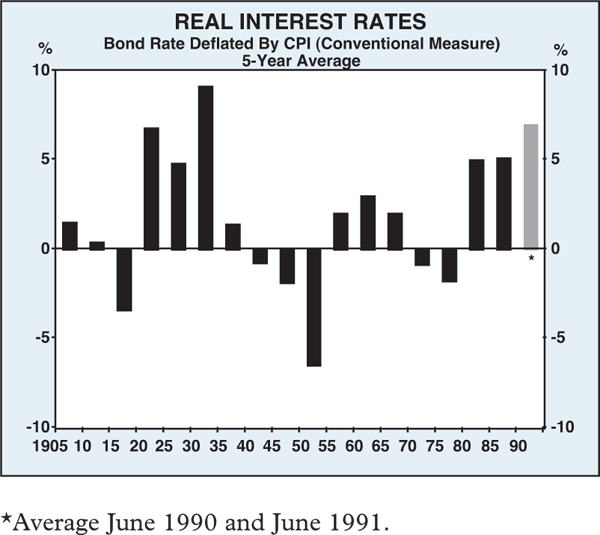
These points limit the scope for formulating firm rules about real interest rates for monetary policy purposes. Carefully interpreted, however, they can provide some useful information on economic behaviour.
Real Interest Rates in the 1970s and 1980s
Real interest rates have varied widely over recent decades. Calculated in the conventional manner – that is, deflating the nominal interest rate by the rate of inflation over the previous 12 months (Graphs 2 and 3) – we see that:
- in the 1960s, real interest rates were close to the long-term average of about 1½ per cent;
- in the 1970s, they fell sharply, and were negative for much of the decade;
- in the 1980s, they rose to very high levels.
These observations apply broadly whether we look at short-term interest rates or long-term interest rates.[1] Graphs 2 and 3 also show that the average experience of G7 countries has many similarities to that of Australia.
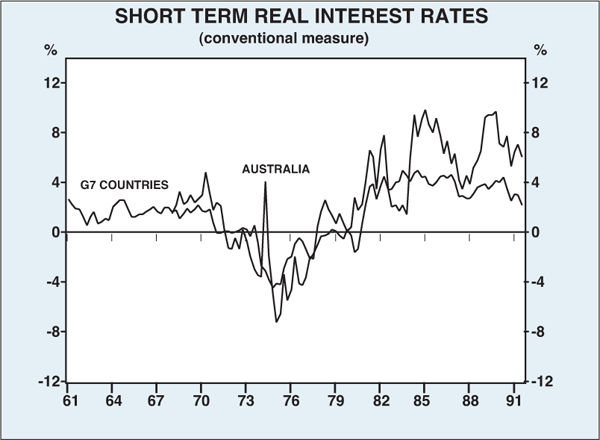
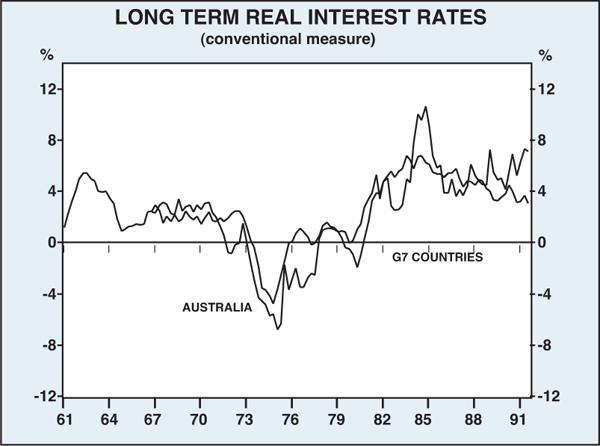
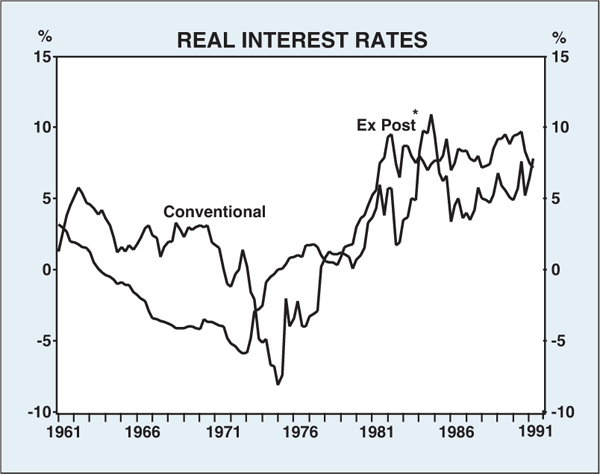
Many factors influence real interest rates. The most obvious are demand and supply factors. Real rates could be expected to rise, for example, in periods when business investment surges, or savings fall sharply, or large budget deficits emerge. Those factors no doubt contribute to variations in real interest rates.
But other influences are also involved. The thrust of this talk is that the interaction of monetary policy, inflation and inflationary expectations also exerts a major influence on real interest rates. This influence probably accounts for more of the variability in real interest rates than raw supply and demand factors, although in practice they all interact. The inflation factor, however, helps to explain why, at different times, people have lent at negative real interest rates and have been prepared to borrow at very high real interest rates.
The two main props to this story are inflationary expectations and inflation/tax distortions. Each is addressed in turn.
Inflationary Expectations
The 1970s
Why did people lend funds at very low – and often negative – real interest rates in the 1970s? Were they stupid, or just unlucky? With the benefit of hindsight, it seems surprising that even professional money managers should have bought bonds and debentures, and made fixed-rate mortgage loans during this period.
We should not allow ourselves any feelings of superiority just because we have the benefit of hindsight. The fact is that many investors in the 1970s were the victims of an unanticipated rise in inflation.
Having become accustomed to low inflation during the 1960s (averaging 2½ per cent over the decade), investors could not foresee the sharp jump in the early 1970s, with inflation spiralling to 18 per cent in 1974. Such increases were outside their range of experience. By 1976 they were still in a difficult position. By then they had a few years of very high inflation behind them, but what were they to expect for the future? Should they assume inflation would continue at its recent exceptionally rapid rate, or could they expect it to be brought under control and quickly return to the levels experienced in the 1960s? Many, apparently, thought the latter.
One thing we have learnt over the years is that it takes a long time for inflationary expectations – and then business strategies – to adjust to changing circumstances. Two examples will illustrate this:
- When Australian Savings Bond (ASB) No. 1 was introduced in January 1976 subscriptions flooded in. The issue had to be closed early for fear that it would cause problems for the savings banks and building societies. Investors thought the 10½ per cent interest rate on offer was too good to be true – not just the mums and dads, but also many big players who were subscribing in units of $100,000. Inflation at the time was higher than 10½ per cent but the general expectation seemed to be that there would be a quick return to the more familiar rates of the 1960s. In the event, inflation declined only slowly and the real yield of ASB No.1 was pretty miserable – only 0.6 per cent per annum if held to maturity.
- Life offices in the 1970s engaged in a lot of long-term, fixed-interest lending, and frequently provided developers of commercial buildings or housing estates with mortgage finance. In the 1970s the developers did very well out of this borrowing as inflation pushed up property prices. The lenders, however, did very badly, with many loans in their portfolio earning interest rates much lower than they could earn through new lending. By the 1980s the big institutions had learnt their lesson and stopped providing fixed-term credit; in some cases they (and several finance companies) switched to providing equity through joint property ventures – financing, in retrospect, they should perhaps have been doing in the 1970s!
As I say, these examples illustrate that:
- even professional investors can lose money through unanticipated changes in the rate of inflation;[2] and, more importantly,
- it can take a long time for people to, firstly, adjust their inflationary expectations and, secondly, adjust their business strategies.
Of course, other factors were at work during the 1970s. In particular, interest rate ceilings on bank deposits and the fact that the Government set the yields on its own debt introduced important rigidities. Nominal interest rates were slow to adjust upwards because such adjustments required politically unpopular government decisions. This slowness exacerbated inflationary pressures, although over time some adjustments were made. Without these ceilings, nominal interest rates would probably have risen more quickly, although we still would have seen negative real interest rates (as we did in most OECD countries, some of which had looser controls on interest rates than Australia).
Interest rate ceilings, however, should not have prevented bigger players from making a positive real rate of return on their savings. Those who made $100,000 subscriptions to ASB No. 1 had choices beyond government bonds and bank deposits, including the purchase of equities or property. That many did not pursue those latter courses suggests that they expected to get a reasonable return from ASBs. Similarly, professional funds managers did not have to make mortgage loans or buy debentures, but many did so because they too were slow to accept the change in the inflationary environment.
Gradually, however, inflationary expectations adjusted upwards. This was kicked along throughout the world by further large increases in oil prices in 1979. For some countries, including the United States, inflation was higher in the early 1980s than it had been in the mid 1970s. By 1982, when the first bond tender was held in Australia, yields reached 16.6 per cent, which were high in real terms, however measured. Bond yields remained high for the rest of the decade, being generally within a 12 to 15 per cent range. Inflation by this time had declined well below its rate in the 1970s, averaging 7 to 8 per cent over the period in question. Yet real rates of interest remained high in the 1980s, whether calculated on a conventional or ex post basis. Why were real rates so high in the 1980s, when inflation itself was on a downward trend?
The 1980s
The answer in part is in the mirror image of the 1970s experience. After that decade of very high inflation, in Australia and abroad, inflationary expectations adjusted upwards. (Inflation fell briefly to around 5 per cent in 1984, following a recession and a wage freeze, but inflationary expectations did not adjust downwards.)
In this climate of entrenched high inflationary expectations, it became difficult to find investors who were prepared to lend long term at fixed rates. The smell of burnt fingers in the 1970s lingered on. Even lenders whose inflationary expectations had begun to turn downwards still demanded a risk premium as insurance against a resurgence in inflation. High interest rates had to be offered to coax lenders out of the woodwork. In contrast to the 1970s, funds managers and others were now more interested in buying equities and property.
While high inflationary expectations reduced the willingness to lend long term at fixed rates, they whetted the appetite for borrowing. Many assumed inflation would continue to whittle away the real value of their borrowings, and at the same time push up the value of acquired real assets. Borrowers were also very aware that they could write off the full borrowing costs against current income for tax purposes, even though the inflation component was implicitly a repayment of capital.
In these ways, entrenched high inflationary expectations contributed to the asset price boom in the second half of the 1980s. They also help to explain the conundrum that very strong demand for credit could persist notwithstanding some very high real interest rates. After a time, of course, that demand could not be sustained, and high real interest rates eventually won out. But we were all surprised by how far real interest rates had to be pushed up, and how long they had to be kept there, to check the asset price boom and associated heavy demand for borrowed funds.
The Inflation/Tax Distortion
The mechanics of a conventional tax system, as exists in all major countries, also contribute to high real interest rates in an inflation environment. This is because both the nominal and real component of interest are deductible for tax purposes. Consequently, the higher the inflation component of nominal interest rates, the higher the nominal rates have to be raised to achieve any given after-tax real interest rates. To the extent that it is the latter that matters for many borrowing decisions, the achievement of a given contractionary policy stance will require a higher before-tax real interest rate, the higher is the rate of inflation.[3]
In Australia in the late 1980s, there was little choice but to persevere with high real interest rates if inflation was to be tackled seriously. No one needs to be reminded that the effects of those high real interest rates have been far-reaching. Their effects, moreover, are not confined to domestic borrowing decisions. If high inflation countries have higher real interest rates as a consequence, then real exchange rates might also be pushed up as foreign investors are attracted by the high real interest rates. High inflation economies might actually go through periods of upward pressure on their exchange rates. We have seen this in a number of countries, including Australia in recent times. The United Kingdom, Canada and New Zealand in the late eighties provide further examples, while some new European Exchange Rate Mechanism entrants, such as Spain, have exhibited the same characteristic.
International Experience
I observed earlier that most countries experienced generally low or negative real rates in the 1970s and generally high, positive rates in the 1980s.
It seems clear that when the largely unanticipated lift in inflation occurred in the 1970s, the countries that experienced the highest rates of inflation tended to have the most negative real interest rates (Graphs 5 and 6). In other words, inflationary expectations had furthest to adjust and, while they were adjusting, real interest rates (as measured) were often significantly negative.
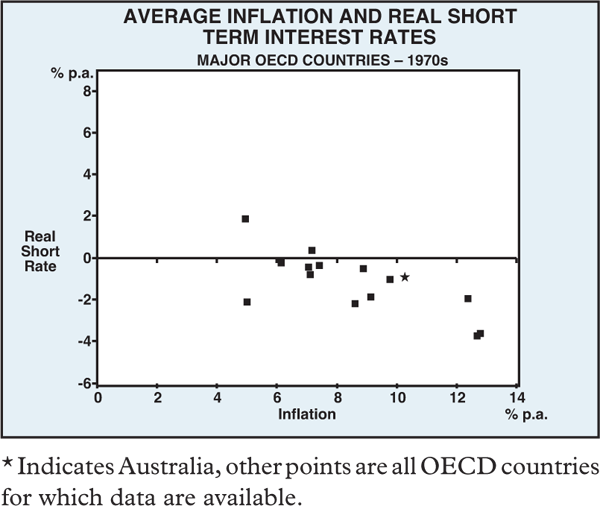
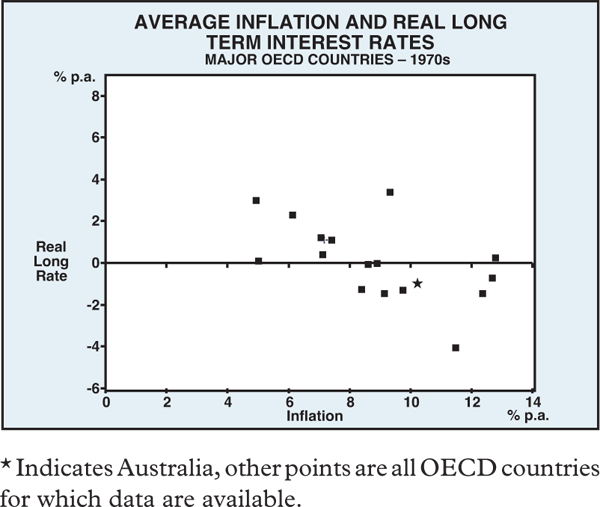
Again, the 1980s were a mirror image of the 1970s. Although most countries achieved lower inflation rates in the 1980s than in the 1970s, they did so with varying degrees of success. Those countries that were least successful in reducing inflation tended to have higher real interest rates at the short end than the more successful countries (Graph 7). It is at the short end that monetary policy directly does its work and monetary policy has had to work harder in the higher inflation countries. Australia, not surprisingly, is one of the observations in the top right portion of the scatter diagrams shown in Graphs 7 and 8.
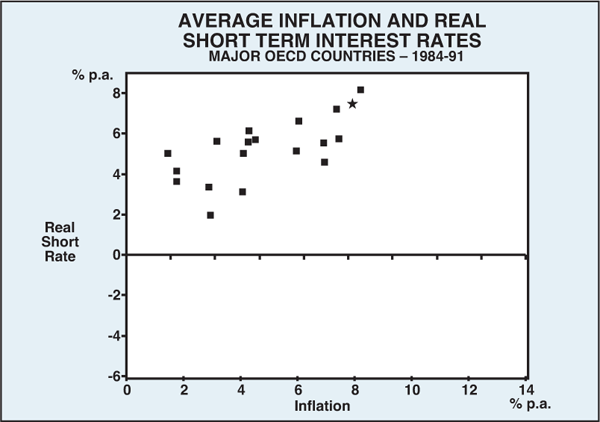
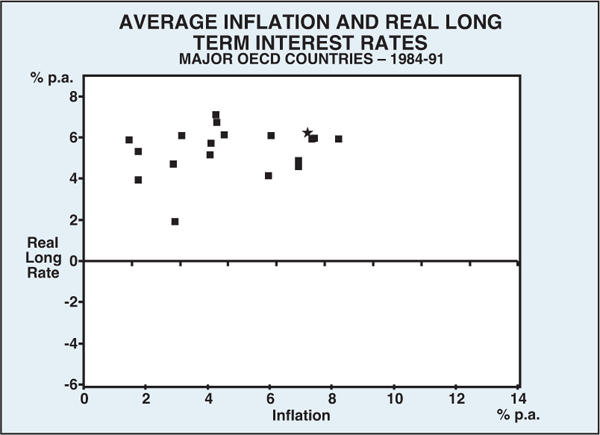
Outlook for the 1990s
Real interest rates in the 1990s has been a popular topic for discussion around the world. Much of the discussion has focussed on an anticipated world capital shortage which reflects projected demands for funds from eastern Europe, the Soviet Union and the Middle East, piled on top of the on-going and increasing demands from traditional developed and developing countries.
Every decade, however, generates massive demands for capital, which are bound to outstrip the funds available. In the 1990s, as in earlier decades, the rationing will ultimately occur in the market place; proposals which do not generate acceptable rates of return will not go ahead (or, if they do, they do so at the expense of other, more productive projects). Our hunch is that it will be some years yet before projects in eastern Europe or the Soviet Union can jump the required hurdle rates of return in such numbers as to impose major additional demands on world capital markets.
Australia must still compete with all comers for its share of the world's scarce capital; how it does that is largely outside the scope of today's talk. What happens to real interest rates in Australia in the 1990s, however, will depend importantly on what happens to inflation and inflationary expectations.
Given time, inflation gets incorporated into the structure of nominal interest rates, and lower inflation therefore allows lower nominal rates. The question is whether the relationship is one for one, or whether real interest rates are also affected. There is no straightforward answer to this question: for one thing, the stage of the cycle and the outlook for economic activity have to be taken into account, as well as inflation. The odds are, however, that if we succeed in lowering inflation, and creating expectations that it will stay down for the foreseeable future, then there is likely to be scope for real interest rates (as conventionally measured) also to be lower.
As shown in Graph 2, short-term real rates have been declining in Australia over recent years although they remain relatively high. As the economy slowed and inflationary pressures receded, nominal interest rates were lowered while retaining the anti-inflationary stance of monetary policy. They were lowered further than the fall in inflation so that real interest rates also fell – which was appropriate, given the phase of the cycle.
Even so, monetary policy has been generally tougher in the downward phase of this cycle than in previous cycles. The payoff has been sharply lower inflation and a lower level of inflationary expectations. The costs have been substantial in terms of lost production and unemployment, although those costs cannot be all attributed to tight monetary policy. There is, however, no alternative to the present monetary policy strategy of continuing to bear down on inflation while remaining alert to the need to encourage economic recovery.
The timing of any further reductions in official interest rates will depend, as with earlier reductions, on developments in both inflation and economic activity. The latter, which has been weaker than generally expected, is forecast to recover moderately during 1991/92. Recent falls in interest rates will help the recovery but monetary policy can best help in delivering sustained economic growth by maintaining a low-inflationary environment. Given such an environment and further structural changes of the kinds that have been occurring over the past five years, we will be well placed to reap that economic growth.
Fortunately, we have been doing much better on inflation than was generally expected and further gains are in prospect over the quarters ahead. This improved performance is gradually permeating the inflationary expectations of consumers, businesses, unions and financial markets. As we have seen in earlier decades, however, it can take some time for expectations about future inflation to be firmed up and incorporated into decision making.
While inflationary expectations in Australia have been declining over the past year or so, strong residual fears remain in some quarters that inflation will bounce back. That is why lenders continue to build in a risk premium. It is also why the Reserve Bank – while prepared to initiate responsible reductions in interest rates ahead of the market – has been nonetheless cautious about lowering rates until there is evidence that inflationary expectations are continuing to decline.
We continue to believe that we now have the opportunity to get inflation back to 1960s rates. We have said repeatedly that Australians should not fatalistically accept that we are a high inflation/high interest rate country. Indeed, over most of this century, Australia had one of the better inflation records of any country. If inflationary expectations can be moved to a permanently low level, we can have lower nominal interest rates, lower real interest rates, a more productive mix of investment and, in the longer run, stronger growth and higher real income.
Endnotes
In passing, it might be noted that the results for bond yields do not depend on using the past year's inflation rate. The real interest rate based on the actual inflation rates over the life of the bond shows a similar picture (Graph 4). [1]
The purist would no doubt argue that our measures of inflationary expectations (conventional and ex post) are wrong – that the investors must have had different expectations about inflation or they would not have made the investments they did. We will never know what those individual expectations were but the practical point is that, ex post, they were wide of the mark; this caused investors to change their expectations, and their behaviour and strategies. [2]
If we start from a position where inflationary expectations are, say, 3 per cent and nominal interest rates are 5 per cent, and the corporate tax rate is 39 per cent, the after-tax real interest rate is .05 per cent. If inflationary expectations were to rise to 10 per cent, nominal interest rates would have to rise to 16½ per cent in order to restore the real after-tax interest rate to .05 per cent. In the process, the pre-tax real interest rate (the one we measure) would rise from 2 per cent to 6½ per cent. [3]
